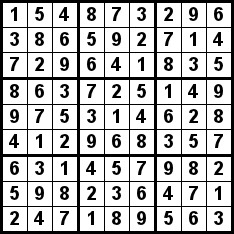You are given a correct solution of the sudoku puzzle. If you don’t know what is the sudoku, you can read about it here.
The picture showing the correct sudoku solution:

Blocks are bordered with bold black color.
Your task is to change at most $9$ elements of this field (i.e. choose some $1 \le i, j \le 9$ and change the number at the position $(i, j)$ to any other number in range $[1; 9]$) to make it anti-sudoku. The anti-sudoku is the $9 \times 9$ field, in which:
- Any number in this field is in range $[1; 9]$;
- each row contains at least two equal elements;
- each column contains at least two equal elements;
- each $3 \times 3$ block (you can read what is the block in the link above) contains at least two equal elements.
It is guaranteed that the answer exists.
You have to answer $t$ independent test cases.Input
The first line of the input contains one integer $t$ ($1 \le t \le 10^4$) — the number of test cases. Then $t$ test cases follow.
Each test case consists of $9$ lines, each line consists of $9$ characters from $1$ to $9$ without any whitespaces — the correct solution of the sudoku puzzle.Output
For each test case, print the answer — the initial field with at most $9$ changed elements so that the obtained field is anti-sudoku. If there are several solutions, you can print any. It is guaranteed that the answer exists.Exampleinput
1 154873296 386592714 729641835 863725149 975314628 412968357 631457982 598236471 247189563
output
154873396 336592714 729645835 863725145 979314628 412958357 631457992 998236471 247789563
Solution:
#include <bits/stdc++.h>
using namespace std;
int main() {
ios::sync_with_stdio(false);
cin.tie(0);
int tt;
cin >> tt;
while (tt--) {
vector<string> s(9);
for (int i = 0; i < 9; i++) {
cin >> s[i];
}
vector<int> a = {0, 4, 8, 1, 5, 6, 2, 3, 7};
for (int i = 0; i < 9; i++) {
int j = a[i];
s[i][j] = (s[i][j] == '9' ? '1' : s[i][j] + 1);
}
for (int i = 0; i < 9; i++) {
cout << s[i] << '\n';
}
}
return 0;
}

